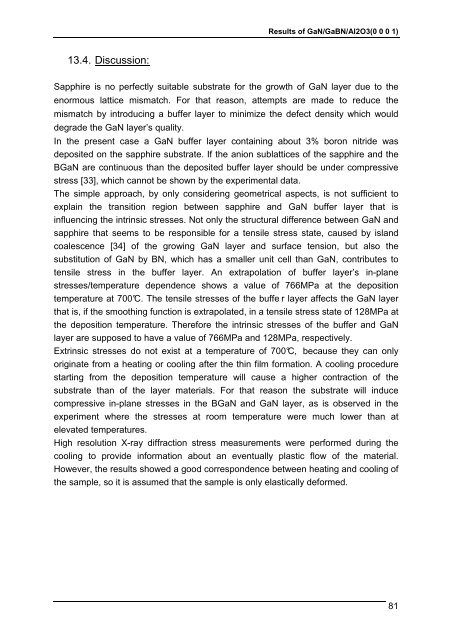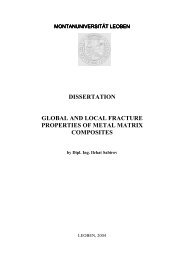Diploma Thesis - Erich Schmid Institute
Diploma Thesis - Erich Schmid Institute
Diploma Thesis - Erich Schmid Institute
Create successful ePaper yourself
Turn your PDF publications into a flip-book with our unique Google optimized e-Paper software.
13.4. Discussion:<br />
Results of GaN/GaBN/Al2O3(0 0 0 1)<br />
Sapphire is no perfectly suitable substrate for the growth of GaN layer due to the<br />
enormous lattice mismatch. For that reason, attempts are made to reduce the<br />
mismatch by introducing a buffer layer to minimize the defect density which would<br />
degrade the GaN layer’s quality.<br />
In the present case a GaN buffer layer containing about 3% boron nitride was<br />
deposited on the sapphire substrate. If the anion sublattices of the sapphire and the<br />
BGaN are continuous than the deposited buffer layer should be under compressive<br />
stress [33], which cannot be shown by the experimental data.<br />
The simple approach, by only considering geometrical aspects, is not sufficient to<br />
explain the transition region between sapphire and GaN buffer layer that is<br />
influencing the intrinsic stresses. Not only the structural difference between GaN and<br />
sapphire that seems to be responsible for a tensile stress state, caused by island<br />
coalescence [34] of the growing GaN layer and surface tension, but also the<br />
substitution of GaN by BN, which has a smaller unit cell than GaN, contributes to<br />
tensile stress in the buffer layer. An extrapolation of buffer layer’s in-plane<br />
stresses/temperature dependence shows a value of 766MPa at the deposition<br />
temperature at 700°C. The tensile stresses of the buffe r layer affects the GaN layer<br />
that is, if the smoothing function is extrapolated, in a tensile stress state of 128MPa at<br />
the deposition temperature. Therefore the intrinsic stresses of the buffer and GaN<br />
layer are supposed to have a value of 766MPa and 128MPa, respectively.<br />
Extrinsic stresses do not exist at a temperature of 700°C, because they can only<br />
originate from a heating or cooling after the thin film formation. A cooling procedure<br />
starting from the deposition temperature will cause a higher contraction of the<br />
substrate than of the layer materials. For that reason the substrate will induce<br />
compressive in-plane stresses in the BGaN and GaN layer, as is observed in the<br />
experiment where the stresses at room temperature were much lower than at<br />
elevated temperatures.<br />
High resolution X-ray diffraction stress measurements were performed during the<br />
cooling to provide information about an eventually plastic flow of the material.<br />
However, the results showed a good correspondence between heating and cooling of<br />
the sample, so it is assumed that the sample is only elastically deformed.<br />
81

















